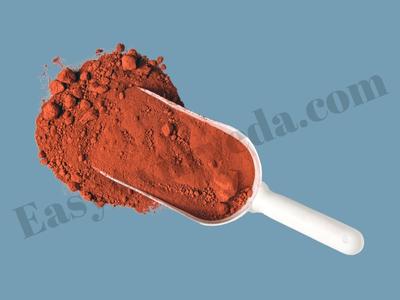Gairika (Red oxide of Iron): Synonyms, Types, Shodhana, Marana, Qualities
Gairika is an ore of iron. It is called as red oxide of iron. It is available in its free form. Nowadays, from this ore only maximum Iron is produced. It is a special type of mud available in mountain regions. It is considered as Upadhatu of Loha, because it’s Satwapatana gives Loha.
Table of Contents
Synonyms

Raktadhatu – red in color,
Lohadhatu – iron red in color,
Gaireya, Girimruttika, Girika, Gairika, Girimrudbhava – it is obtained from the red type of mud found in mountains.
Availability
Available in many parts of India, mainly in Bihar. It is also available in USA, Germany, etc. places.
Types
I – Swarna gairika, Samanya Gairika and Pashana Gairikia
II – According to Rasarnava – based on colour – Rakta, hema and Kevala Gairika.
III – According to Rasasratna samucchaya, which is widely accepted – there are two types –
1. Pashana gairika – Hard, copper red colour.
2. Swarna gairika- Soft to touch – reddish colour.
Suitable characters
Grahya lakshanas – For medicinal usage, Swarna gairika is used. It should be red in colour, unctuous and soft in nature.
For Satwapatana, Pashana Gairika is used. It is hard and stoney in consistency, coppery red in colour.
So, for all therpauetic purposes, Swarna gairika is used. –
पाषाण गैरिकात् श्रेष्ठं कथितं स्वर्ण गैरिकम् ।
अतः सर्वत्र मतिमान योजयेत् स्वर्ण गैरिकम् ॥ (र.त.२२/११३)
pāṣāṇa gairikāt śreṣṭhaṃ kathitaṃ svarṇa gairikam |
ataḥ sarvatra matimāna yojayet svarṇa gairikam || (ra.ta.22/113)
Gairika Shodhana
गैरिकं तु गवां दुग्धैर्भवितं शुद्धिमृच्छति । (र.र.स.३/४९)
gairikaṃ tu gavāṃ dugdhairbhavitaṃ śuddhimṛcchati | (ra.ra.sa.3/49)
Gairika can be purified by giving bhavana with cow milk.
Other than this, the following methods can be adopted for Gairika Shodhana.
- Frying with quarter part of ghee in an iron ghee.
- Swedana with Kanji for three hours.
- Bhavana with jambeeri Nimbu.
Marana of Gairik
Since shuddha Gairika is available in Bhasma form, marana procedure is not adopted.
Satwapatana of Gairikam
Individual swedana is given with Kshara and Amla substances, Bhavana is done with Dravaka gana dravyas, and cakes are made, takein in Musha and subjected to intense heat, to obtain Satwa, similar to Loha.
Dosage
2 – 4 ratti (250 mg to 500 mg) per day in divided doses
Useful Formulations
Irimedadi taila
Gairikadya pralepa
Jwarankusha rasa
Pushyanuga churna
Laghusutashekara rasa
Qualities
Snigdha – nctuous, oily,
Kashaya – astringent,
Madhura – sweet,
Sheeta veerya – cold in potency,
kaphapittanashaka – pacifies Kapha and Pitta,
Chakshushya – good for eyes,
Sthambhana – styptic,
Raktashodhaka – purifies blood,
Vishaghna – anti-poisonous
Useful in:
raktarsh – bleeding hemorrhoids,
raktapradara – menorrhagia,
Netraroga – eye diseases,
Visphota – bullous eruptions,
Visarpa – herpes,
Hikka – hiccup,
Visha – poisoning,
Vrana – wounds and
Agnidagdah – burns.
Shelf life:
5 years.
If Bhavana is done with milk and if it is not dried properly, then the shelf life gets reduced to 1 – 3 years only.









